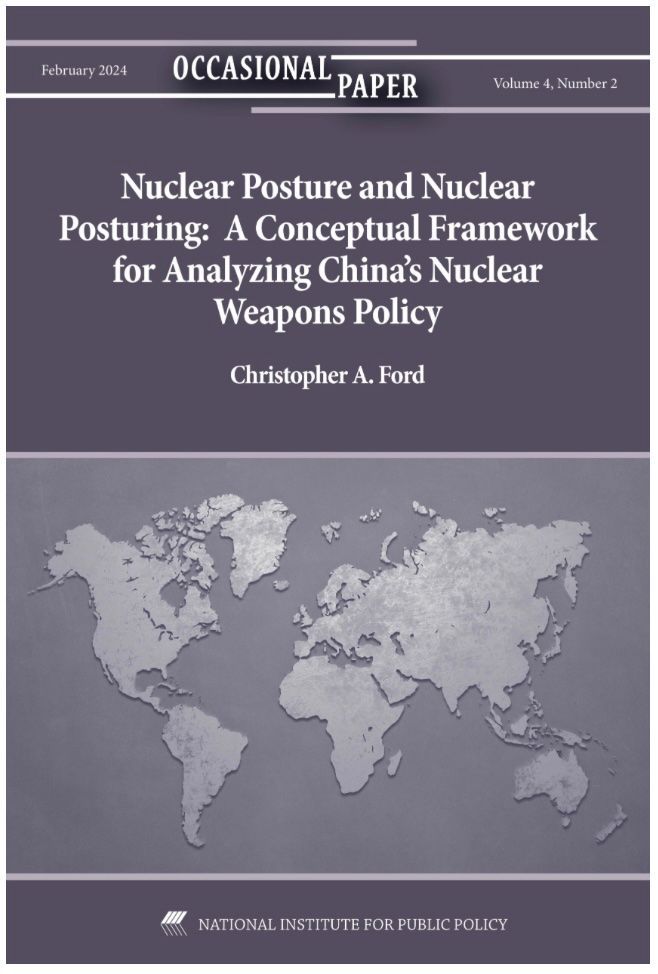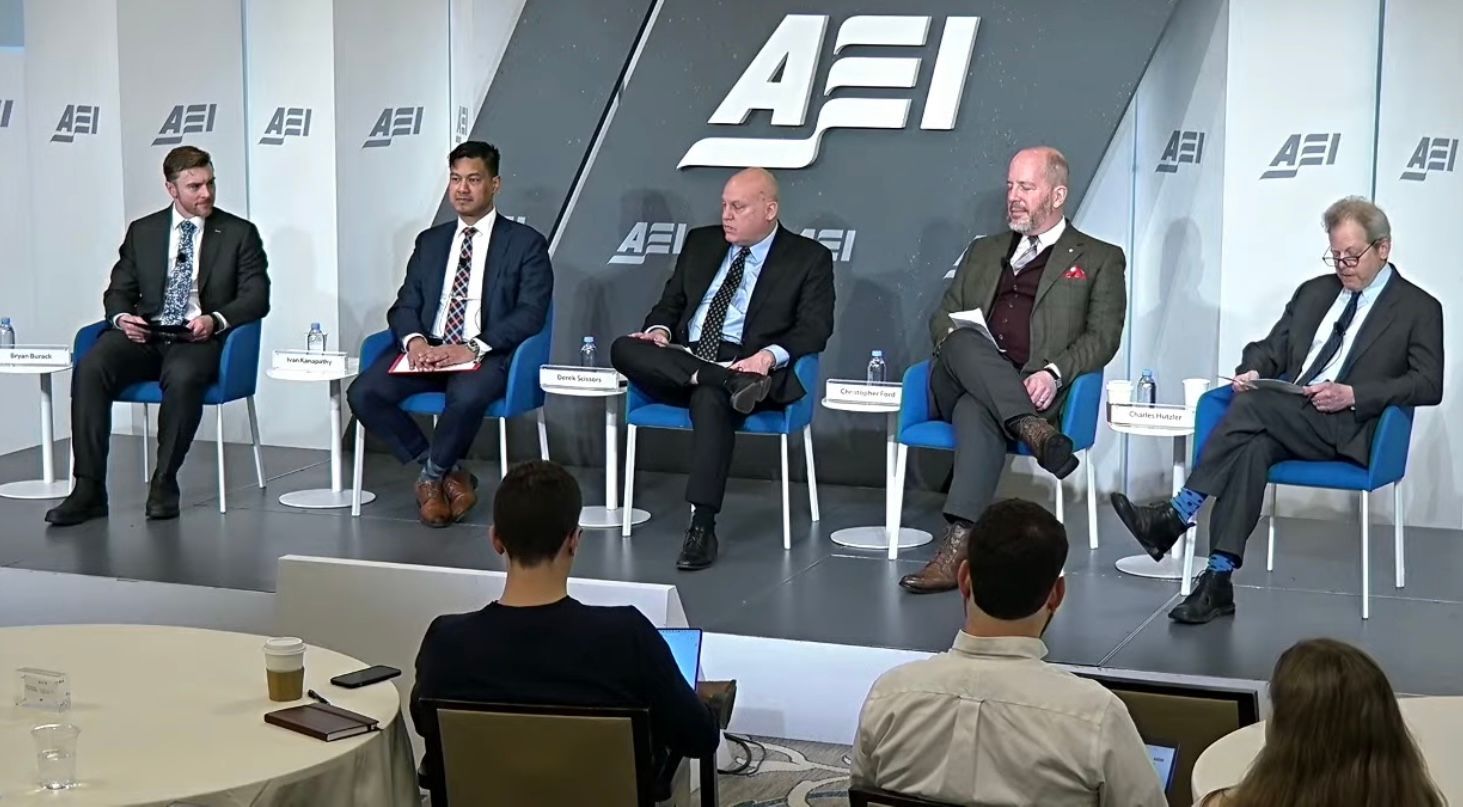The Hon. Christopher A. Ford
New Paradigms Forum -- International Security Policy Since 2009
Assessing the Bush-Obama doctrine of “global” counter-terror “war”
The “War” and its Critics
After the terrorist attacks of September 11, 2001, U.S. officials began referring to the struggle the Untied States had entered as a “global war on terrorism.” (My Navy uniform even has a medal emblazoned with the phrase – which in military jargon quickly became “the GWOT,” an ugly-sounding word that is pronounced gwot ). This phrasing wasn’t accidental, nor was it figurative: U.S. officials literally felt themselves to be at war. Moreover, as soon became apparent in Afghanistan and elsewhere, they took the legal position that U.S. forces were free to operate with wartime-style rules of engagement against members of al-Qa’ida and allied groups wherever such terrorists might be found. That meant killing them upon encounter anywhere – the whole world was now a potential “battlefield” between U.S. forces and these terrorists – and if terrorist combatants were captured, holding them until the end of the war, whenever that would be.
President Obama’s new team doesn’t like using the term “war on terrorism” very much, and is phasing out the term. Significantly, however, this is for political , not legal reasons. (The phrase seems to them a bit harsh, belligerent, unsympathetic, and otherwise … well, Bushlike.) But the desire to sound different hasn’t stopped the Obama Administration from embracing the basic Bush legal theory with gusto. Obama has even stepped up, rather than diminishing, the use of unmanned aircraft to rain missiles upon suspected terrorists in Pakistan, where U.S. troops do not seem otherwise to be engaged in hostilities at all. (And as for Obama’s initial promise to close down the enemy combatant detention facility at Guantanamo as an unsavory legacy of Bush extremism … well, you can read the newspapers.) All in all, in other words, the United States still considers itself quite literally “at war” with al-Qa’ida on a fully global basis. Let’s call this the Bush-Obama legal doctrine of counter-terrorist armed conflict.
Enter the unhappy law professors.
In the spring of 2005 – after President Bush’s re-election – the Executive Committee of the International Law Association (ILA) asked its “Use of Force Committee” (UFC) to study the question of how to define “armed conflict” under international law. In August 2008, the UFC presented its Initial Report – an account of which was published by its chairman, Mary Ellen O’Connell. (See Mary Ellen O’Connell, “Defining Armed Conflict,” Journal of Conflict & Security Law , vol.13, no.3, at 393-400.)
The UFC came out against the Bush-Obama theory. As recounted by O’Connell, it reasoned that the definition of “armed conflict” under international law required two things: the existence of organized armed groups; and these groups engagement in “fighting of some intensity.” How “intense” things need to be was apparently not explained, but the U.S. legal theory – that the 9/11 attacks had created a global conflict justifying attack upon al-Qa’ida terrorists anywhere – was said to be “unjustifiable” and “not consistent with the Use of Force Committee’s report” because fighting was not of sufficient “intensity” outside the specific theaters of Afghanistan and Iraq.
There’s Politics … and then there’s Politics
Interestingly, the UFC seems initially to have been frustrated by the legal position taken by the International Committee of the Red Cross (ICRC) in “argu[ing] for a very low threshold” for the existence of an “armed conflict.” This was rather inconvenient, because if the ICRC was right that the law didn’t require much, then perhaps such a conflict did exist on a global scale – which might mean that (gasp!) the Bush-Obama theory was correct and it was permissible for U.S. forces to go terrorist hunting outside Afghanistan and Iraq.
This annoying obstacle was eventually surmounted, however, by the UFC’s breezy conclusion that for these purposes the ICRC could simply be ignored. Why? Because, recounts O’Connell, its position was “based on policy rather than, perhaps, its view of what the Conventions require as a matter of law.” (If armed conflicts were not easily created, people would need the ICRC’s services less frequently. Res ipsa loquitur.) Those poor benighted hacks at the International Committee of the Red Cross, in other words, took legal positions for political reasons – because they wanted them to be true, rather than because they were true – while the sublimely disinterested and entirely apolitical law professors of the UFC are entirely above such things and could simply dismiss the ICRC’s awkward legal arguments as mere policy advocacy.
OK, maybe. But wasn’t that a little too easy? Dismissing contrary positions by assuming them to be driven by “policy” rather than legal propriety is rather a curious door to open for a group that found the post-2001 U.S. position in need of critical examination precisely because it differed from the positions taken by other countries which in the past “have preferred to deny being engaged in armed conflicts even when they plainly are.” Those governments, the UFC’s phrasing makes clear it believed, were clearly taking legal positions on the basis of policy motives. (They really were in armed conflicts, but wanted to duck their responsibilities under the Geneva Conventions and thus merely pretended that they weren’t.) Unlike the arguments of the ICRC, however, these governments’ positions aren’t discounted on account of their political origins. In fact, the UFC thereafter assumes these governments’ articulation of a high conflict threshold to be, in effect, the norm that makes the Bush Administration’s position so anomalous and in need of critical examination. Hmmmm.
State Practice versus Wishful Thinking
Stranger still, the UFC’s phrasing also makes clear that it thought the claimed views of these other governments – espousing a high threshold for the triggering of “armed conflict” – to be legally wrong. According to the O’Connell, these governments deny being in armed conflicts when “they plainly are.” (Translation: the threshold for armed conflict is really lower than these governments claimed.) For the UFC, therefore, the threshold of “armed conflict” is low when this allows legal scholars to criticize countries such as El Salvador for abusing communist guerrillas, but high when this allows them to criticize U.S. counter-terrorist operations. Good thing it’s only the ICRC that plays politics with its legal positions!
The only way for these two propositions to be true is for state practice – for instance, in the adoption of certain military tactics and the articulation of legal bases for them – to be unimportant. The law professors know the law better than national leaders, and can see through the hypocritical pretenses of governments who advance legal positions only in order to rationalize their brutal policies. El Salvador, we might infer, was wrong because that country really was in a real armed conflict, while the United States was wrong because it really wasn’t. The UFC can pierce the veil.
But there’s a problem with this. Elevating the opinions of legal scholars to a position in effect superior to that of state practice as a source of international law may produce compelling policy advocacy, but it isn’t very good lawyering. As suggested by Article 38 of the Statute of the International Court of Justice (ICJ), for example, state practice is unquestionably a principal source of international law, while even the most passionately-held and articulately-defended opinions of legal scholars amount at best to “subsidiary means for the determination of rules of law.” (O’Connell’s article concedes this, referring “primary” and “secondary” sources, respectively.) Moreover, Article 38 is only a guide to where the ICJ should look to see what the law is; law professors don’t make new international legal rules, they just study them. (For that matter, the ICJ itself doesn’t make law as, for instance, the U.S. Supreme Court likes to do.) States make law – and state practice makes international customary law.
This perhaps can help us shed new light upon the UFC’s report. It was asked to investigate this question because at the time of the September 2001 attacks “no widely accepted definition of armed conflict was recognized by international law scholars.” By 2008, however, as a result of their work, O’Connell’s group happily reported “consensus on the existence” of the abovementioned intensity criterion. Yet technically speaking, a consensus among a group of law professors on the existence of a rule doesn’t necessarily mean that such a rule exists – especially if state practice points in the other direction. No more than for the ICRC, the UFC’s desire for a legal norm doesn’t create one, even in the murky swamp of legal advocacy in an international context often lacking clear definitions and quite free of compulsory adjudication.
Apples and Oranges, and some Overlooked Oranges
When it comes to the actual practice of sovereign states, the drafters of the Geneva Conventions apparently could not – or did not think to – provide a definition of the threshold for armed conflict, and states have apparently advocated inconsistent positions ever since. Perhaps the real answer is that at the time of the September 2001 attacks was not merely that no definition of the armed conflict threshold was “widely accepted,” but in fact that none actually existed – and that things haven’t been conclusively resolved in the intervening years.
To judge by O’Connell’s account of the UFC’s reasoning, the group seems to have compared apples to oranges in drawing its contrast between prior practice and the U.S. “war” on terrorism. As she admits, past state practice in taking a position on the threshold of “armed conflict” concerned internal situations – Sri Lanka and El Salvador are given as examples – in which each government’s forces operated against insurgencies based within their own country. The issue was, as the UFC concedes, whether or not these struggles should be classified as “ internal armed conflicts” within the meaning of the Geneva Conventions.
But that’s not remotely like the situation the United States confronted after 9/11. The interesting and novel aspect of the U.S. legal situation, in fact, is that this depressingly familiar internal armed conflict debate was not in play at all. With September 2001, the Americans faced an armed and organized adversary operating from outside the United States, and the question is whether this struggle should legally be classified as a regular “armed conflict.” The UFC’s comparison of unlike with unlike allowed it to claim that U.S. practice was outlandish and anomalous – a deviation from the alleged “trend” of state practice – but in fact the issues raised in the American case were sui generis , making the GWOT an orange to the apple the UFC identified in other states’ practice.
Or not quite. Actually, the issues raised in the U.S. case have arisen before. It’s just that to judge by O’Connell’s article, the UFC seems to have ignored this precedent – perhaps because it supports the U.S. case. The state of Israel has, for many years now, faced attack from armed groups operating from bases outside its territory, and has responded with tactics that include taking the fight to members of those groups wherever they can be found. This fact pattern is much more similar to the contemporary U.S. situation than any strained comparison with the Sri Lankan civil war against the Tamil Tigers, or with El Salvador’s battle against FMLN guerrillas. Other potential analogies include repeated attacks by South African forces, in the long struggle years before the end of apartheid , upon ANC guerrilla bases in neighboring countries with the forces of which Pretoria was not itself at war. There were also repeated attacks by Rhodesian forces against ZANU and ZAPU guerrillas based elsewhere during Zimbabwe’s guerrilla war.
The UFC confidently declares that “[t]here are few if any examples of states treating minor engagements with other states as armed conflict,” but this focus upon state-versus-state conflict just brings grapes into its already confused fruit salad of dissimilar comparisons. The issue at hand is about armed and organized non-state actors attacking – and being counter-attacked by – a state. If you’re looking for state practice, moreover, it is surely also noteworthy that after September 11 the many countries of the NATO alliance invoked the collective defense provisions of Article 5 of the NATO Treaty for the first time ever, and thereafter jointly undertook combat operations in an area far from the scene of the attacks but where it was believed that al-Qa’ida combatants could be found.
If anything, therefore, the practice of real states in the real world suggests a rule quite the opposite of the UFC’s position that post-9/11 global counter-terrorism operations by American forces are “unjustifiable.” On multiple occasions, when a state has been attacked by an armed group operating from outside its borders, it has adopted wartime-style rules of engagement against combatants belonging to that group without geographic limitation, and has justified this response in the legal discourse of self-defense. Since state practice accompanied by evidence of opinio juris – the belief that such practice is justified or required by principles of law – is generally considered to be a primary source of international legal rules (i.e., customary law), one starts to suspect that the UFC has in fact gotten things precisely backwards.
Living in the UFC’s World
And even if the UFC is right, what kind of an international rule would this actually be? As noted, O’Connell’s group would have it that an “armed conflict” does not develop unless and until engagements with an armed group reach a certain level of intensity. This has some logical appeal, but one key question is: “Where?”
The core of the UFC’s position against the United States is that hostilities with al-Qa’ida and its affiliated terrorist groups have not reached the requisite intensity anywhere other than Afghanistan and Iraq: the Americans’ “global war on terrorism” is not legally a war because “[i]ntense intergroup armed fighting does not characterize the entire globe.” This sounds like another way of saying that a truly “global” armed conflict against terrorists is impossible. (How could intense armed fighting with any imaginable terrorist group ever characterize “the entire globe”?) Instead, the UFC seems to have adopted a territorial “zone of armed conflict” standard tied to national jurisdictions: El Salvador and Sri Lanka were really “armed conflicts” because (despite these governments’ claims) the fighting within the boundaries of those countries had reached the requisite intensity, but the U.S. conflict with al-Qa’ida has not reached that level in any national territory other than Afghanistan and Iraq.
This is a bit hard to swallow. As I noted earlier, the contemporary counter-terrorist struggle is only really interesting – legally speaking, at any rate – precisely because it isn’t just another fight between states … or within any particular state. It is limited to no particular zone or territory. U.S. embassies have been destroyed in Nairobi and Tanzania, a U.S. warship attacked in Yemen, skyscrapers attacked and then re-attacked and destroyed in New York, the Pentagon set ablaze in Washington, an airliner crashed in Pennsylvania, and another aircraft attacked (fortunately unsuccessfully) over the Atlantic. America’s NATO allies Britain and Spain have suffered terrible terrorist bombings in their capitals, and the British, Germans, and others have caught terrorists attempting further attacks. By taking as a starting point the presumption that “intensity” must be judged on a state-territorial basis, however, the UFC effectively presumes its conclusion as well: this unexplained and seemingly unexamined assumption sets up the Committee to conclude that every terrorist attack so far has been, legally speaking, an isolated incident rather than part of a broader struggle. But why, exactly, can “zones of armed conflict” exist only in quanta tied to state boundaries? (And what about the high seas or international airspace? How does one compartmentalize “intensity” in those contexts?)
What’s more, the state-territorial “zone of armed conflict” assumption is problematic even on its own terms. The UFC feels that the fight against terrorists is indeed a legitimate “armed conflict” in Afghanistan, but one wonders how it got to be one in the first place. Interestingly, O’Connell reports that her group was divided between those who felt that a significant unilateral attack could in itself create an “armed conflict” and those who felt that one did not begin until there came a significant “counter-attack.” Either view, however – and for convenience let’s call them the “unilateralist” and the “counter-attack” positions – has its difficulties.
For the first group, a unilateral attack can create an “armed conflict,” provided that this attack is sufficiently “intense.” Did the September 2001 attacks themselves meet this threshold? O’Connell’s article admits that international law does not “require that a certain number of deaths occur before a situation is counted as an armed conflict,” and killing 3,000 people before brunch is no mean military feat from either a quantitative or a qualitative perspective. And if such butchery somehow did not meet the UFC’s standard of intensity, what more would be required? Coupling this with the UFC’s apparent state-territorial nexus, does the UFC think a terrorist group could launch as many 9/11-scale attacks as it wanted against a country’s forces or citizens without creating an “armed conflict” as long as each attack occurred in a different country?
But let’s assume that for this unilateralist UFC sub-group, 9/11 itself qualifies. By the UFC’s logic, however, this attack would have created an “armed conflict” between the United States and the al-Qa’ida group but only within a zone limited to the territory of the United States. It follows that it would be perfectly appropriate for U.S. military forces to use wartime engagement rules against al-Qa’ida combatants wherever they could be found within this zone. Perhaps this would indeed have been legal, and I have reason to believe that some in the U.S. Justice Department’s Office of Legal Counsel believed so as of mid-2002. But would the unilateralist members of the International Law Association’s Use of Force Committee have filed an amicus brief in support of the Bush Administration if a court case had erupted over U.S. Navy SEALs gunning down the members of an al-Qa’ida cell in Detroit? (O’Connell apparently wishes us to believe that only the ICRC plays politics with its legal positions, but I have my suspicions ….)
But as at least politically curious as this unilateralist position seems, it pales beside the legal implications of the “counter-attack” theorists in O’Connell’s group – that is, those who felt that an “armed conflict” only develops when the victim of the first attack fights back. Imagine the rule that would result: armed groups can mount any number of attacks, of any intensity anywhere , and it is not an “armed conflict” unless and until the victim fights back. This however, is deeply paradoxical, and not merely because it is such a queerly asymmetrical, terrorist-privileging standard. More fundamentally, this “counter-attack” theory creates problems with regard to how it is that such a counter-attack is justifiable in the first place.
Let’s take the example of Afghanistan. Al-Qa’ida terrorists attacked the United States in New York and Washington, D.C., and the United States responded by invading Afghanistan to destroy that group’s bases there and oust the Taliban regime that supported it. But the O’Connell group must insist that the September 2001 attacks did not create a “zone of armed conflict” that encompassed Afghanistan. (This would presumably be so either because the conflict zone created by the attacks was limited to the United States itself, or because the attacks created no “armed conflict” at all in advance of an American counter-attack.) After all, the Afghanistan invasion was perhaps the purest example one could imagine of action based upon the Bush-Obama legal theory: the assumption that the terrorists’ attack upon the United States justified engaging al-Qa’ida combatants and their allies wherever they can be found. (As of the autumn of 2001, of course, that meant Afghanistan above all else, even though there was not yet any fighting there.)
The UFC cannot admit that the attacks in New York and Washington justified military operations against al-Qa’ida and its allies in a country thousands of miles away, because this would be to grant U.S. officials precisely the legal leeway they claim. It would be to concede that one can indeed have an “armed conflict” on a truly global basis against an armed transnational group. (If so, the UFC’s entire legal analysis is no more than an exercise in blowing smoke, because apparently attack by an armed group does justify wartime rules of engagement with members of that group wherever they may be found.) In order for O’Connell’s group to attack the Bush-Obama theory, therefore, 9/11 cannot have justified counter-terrorist operations in Afghanistan.
But remember that the UFC seems to feel that there is an “armed conflict” between the United States and the terrorists in Afghanistan. So on what other basis, then, does the UFC believe that the United States invaded Afghanistan? It presumably wasn’t “self-defense,” at least not in the military sense, for how would a country be able to do that outside the context of an armed conflict? If no “armed conflict” existed, should the United States have instead sent only law enforcement teams into Afghanistan to arrest Osama bin Laden rather than CIA and military Special Forces to kill him? But that’s not an attack, which would mean that – for the UFC “counter-attack” theorists, at least – an armed conflict still wouldn’t exist. (Are you getting confused too?) Or is it perhaps simply that there was no “armed conflict” in Afghanistan until the poor victims of al-Qa’ida suffered an “unjustified” American attack and in turn fired back upon us ?
And for those “counter-attack” theorists, moreover, what specifically is it about a counter-attack that triggers the existence of an “armed conflict”? Is it just that two groups actually start exchanging fire, rather than simply having one of them attack unarmed persons on the other side? If so, this would make the September 2001 attacks legally irrelevant : the armed conflict between the United States and al-Qa’ida would stem solely and exclusively from the fact of reciprocal bloodshed in Afghanistan. It would also create a very strange rule whereby each side could trade mere unresisted massacres forever, without a true “armed conflict” existing in the myopic eyes of the law so long as no one returns fire in any specific engagement.
Alternatively, are the attacks in Washington and New York somehow connected to events in Afghanistan – as would seem to be suggested by the concept of a counter -attack as violence that responds to other violence – so that when taken together, they magically add up to the requisite sort of “conflict?” If so, how exactly does this work? And how could a counter-attack be said to “counter” the original attack and create an armed conflict without ushering in the U.S. “global war” theory through the back door? After all, could one not argue based upon the Afghanistan scenario that it becomes an “armed conflict” the instant that one fires back against members of the attacking group, no matter where they are? But how would this be different from the U.S. legal theory? (While your bullets or bombs were en route to their targets, O’Connell’s “counter-attack” theorists would be providing the legal justification for their impact.) The whole thing is a conceptual mess.
Conclusion
The 2008 Initial Report of the UFC is apparently not the group’s final say. According to O’Connell, the group plans to revise and expand their findings into a “Final Report” that is “scheduled for submission in The Hague in 2010.” Perhaps some of these inconsistencies and incoherencies will be fixed in the final version. Most of them seem pretty structural, however, and thus far O’Connell’s account leaves the distinct impression that the Use of Force Committee has engaged more in outcome-driven rationalization than solid legal analysis.
Especially because the UFC apparently admits that no scholarly consensus previously existed on the threshold for armed conflict – and because there appears to be a clear line of counter-terrorist state practice with quite similar specific fact patterns that points in precisely the opposite direction – it is hard not to walk away from her argument with the conclusion that the UFC’s legal theory begs too many questions, contains too many inconsistencies, and requires far too convoluted a line of argumentation for it possibly to be the right legal answer. It may well be that international law simply has no answer on this question at present. (That happens.) If there is a rule derived from state practice, however, the only really similar legal precedents of which I am aware suggest that the Bush-Obama theory is tenable. Professor O’Connell and her friends may not wish it so, but if they want to convince me they’ve got a lot more work to do.
– Christopher Ford



Copyright Dr. Christopher Ford All Rights Reserved






